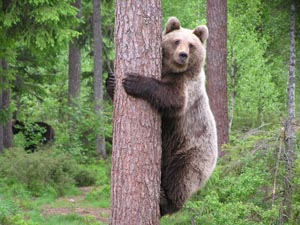"Karelia", ¹ 57 of July 25, 2013
 The multidisciplinary expedition of the Institute of Biology, Karelian Research Centre, Russian Academy of Sciences, which surveyed difficult to access taiga areas in Muezersky, Kalevalsky, and Kostomukshsky Districts is over. One of the aims of the expedition was to study the condition of game animal populations. Another component of the project designed to promote socio-economic development in the Green Belt of Fennoscandia is to investigate the potential for tourism development. The project “Intellectually-driven management of natural resource of Green Belt of Fennoscandia” is implemented within the cross-border cooperation programme funded by the European Union, Russian Federation, and Finland. Other institutes of the Karelian Research Centre also take part in the project.
The multidisciplinary expedition of the Institute of Biology, Karelian Research Centre, Russian Academy of Sciences, which surveyed difficult to access taiga areas in Muezersky, Kalevalsky, and Kostomukshsky Districts is over. One of the aims of the expedition was to study the condition of game animal populations. Another component of the project designed to promote socio-economic development in the Green Belt of Fennoscandia is to investigate the potential for tourism development. The project “Intellectually-driven management of natural resource of Green Belt of Fennoscandia” is implemented within the cross-border cooperation programme funded by the European Union, Russian Federation, and Finland. Other institutes of the Karelian Research Centre also take part in the project.On routes they established across taiga, the scientists recorded the traces of many game animals and birds.
The bear was found to be the true master of the land. Scientists have estimated there are up to three thousands bruins in Karelia altogether. Around Lake Tulos, Muezersky District there is roughly one bear in each one thousand hectares. The bear population density in adjacent areas of the Green Belt in Finland is much lower.
According to the expedition participant specializing in bear studies Konstantin Tirronen, PhD, the bear feels quite at ease in Karelia. There is no reason to be concerned about the species fate. In one of the photographs the scientist made, bear tracks runs over the footprints of frontier guards along the border. Another image is a bear “on watch” – up a tree trunk. That’s some extra security at the border, so to say.
Not all boreal inhabitants are however doing equally well. The reindeer distribution range limit is shifting further northwards. In the Muezersky District, these animals are getting rarer every year, although the lichen the reindeer feed on is plentiful. Yet, the lichen grounds along lakeshores, in open mire sites are hardly used at all. The reindeer are leaving. Why? Scientists speak of the continually growing “nuisance factor”.
Large reindeer herds once used to occur at Kumskoe impounding reservoir (Lake Pyaozero drainage basin) …
– Last winter we had an expedition in this area, – says Konstantin Tirronen. – We saw ski tracks all over the snow cover. Some people came to fish, others just wanted to have fun, ski a little, but some had a very specific objective – to shoot-hunt…
In fact, the better equipped tourists, hunters, poachers become, the harder it is for the animals to find quiet and safe habitats. That is why the timid reindeer move deeper into the woods, avoiding open spaces.
The idea to set up a network of specialized sanctuaries in the republic, where hunting certain animal species would be prohibited, will be discussed at the “Green Belt of Fennoscandia” conference, which will take place at the Karelian Research Centre in October. This conference is included in the plan of major events of the Environment Year approved by the Russian Federation Government.
As of other game animals and fowl, the situation for many is not so good, judging by their declining numbers. The abundance of black grouse, capercaillie, hazel grouse, willow grouse is decreasing. The wolf and the lynx are growing rarer. Only a hundred and fifty wolverines occur in the whole of the republic. Hare numbers have dropped nearly critically…
The Internet is full of ads inviting to hunt wolf, moose, bear, etc. in Karelia. Well-equipped poaching is a big concern for wildlife populations, even though, as scientists believe, the agencies controlling this sphere (Game Directorate, Ministry of Agriculture) now operate more effectively than some ten or fifteen years ago.
As a matter of fact, not all game animals need protection. This is especially the case of excessively reproducing adventitious species – wild boar, beavers, which had not inhabited the territory previously. Encounters with roe deer in Karelian forests are getting more frequent. Moose numbers have grown over the past decade.
Some of the rises/declines in wildlife populations can be explained by so-called “life waves” (cycles recurrence of many natural processes). The results of this expedition may enable the scientists to find explanations also for the processes not related to those waves. They are also expected to provide reasoning for organizing protection of certain wildlife species, as well as proposals on the development of eco-tourism infrastructure.
Of particular interest in this connection is the experience of our neighbours, who build special structures that enable wildlife watching. Bears, for instance, can be baited to such sites (fish wastes may come in handy here). Accommodated in such shelters at a safe distance from the animals, people can feel themselves part of the nature. For bears, too, humans may be a curious sight.
Sergey Khokhlov



